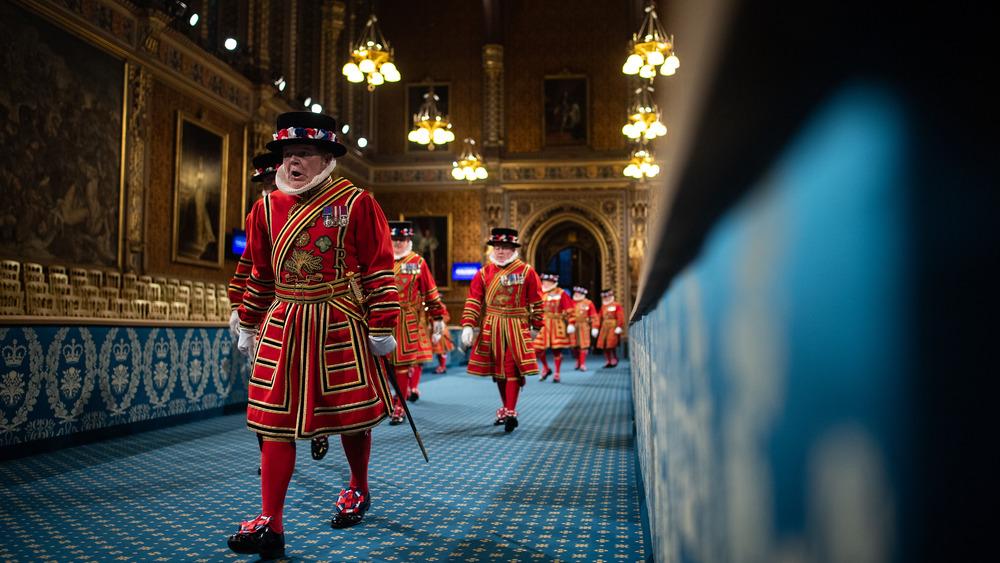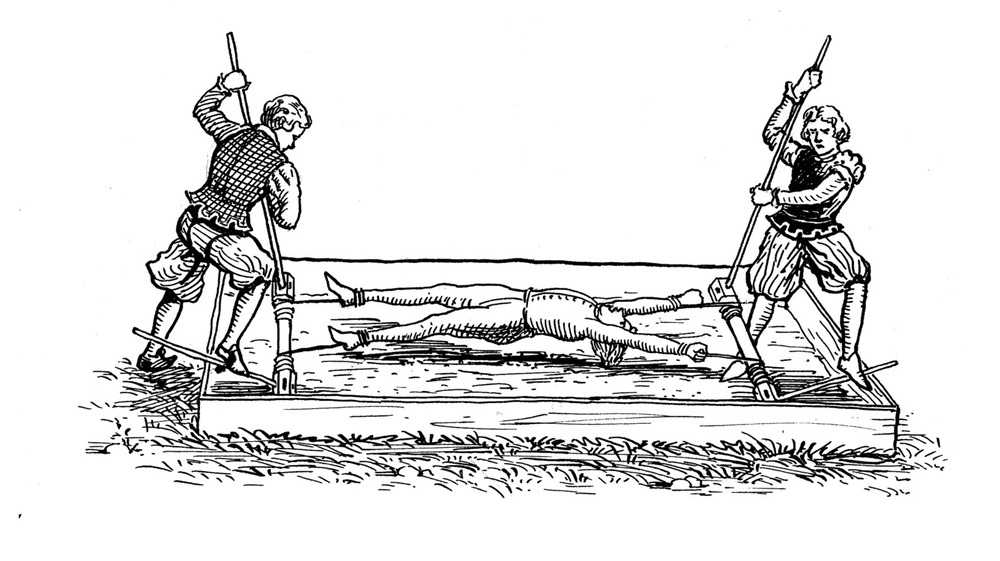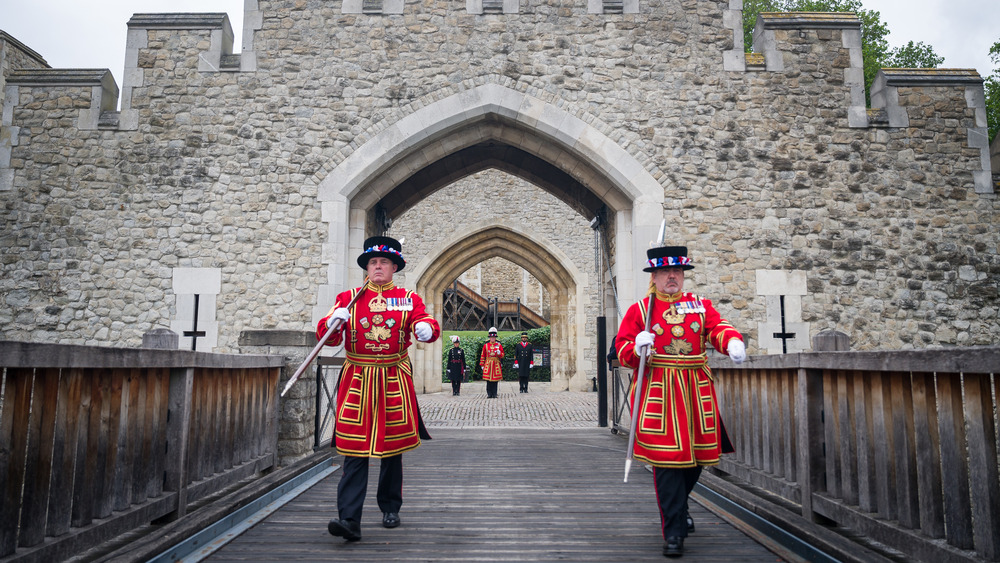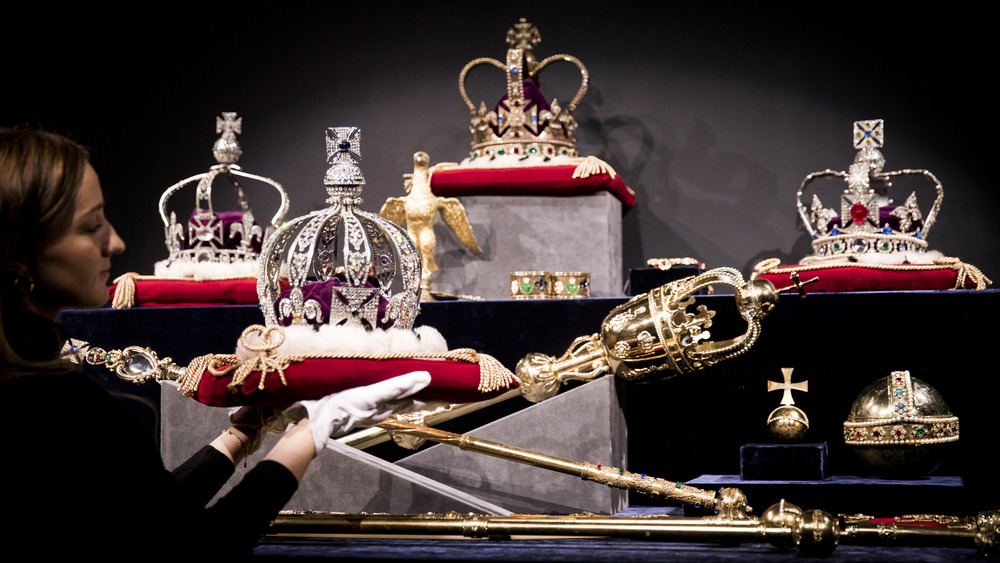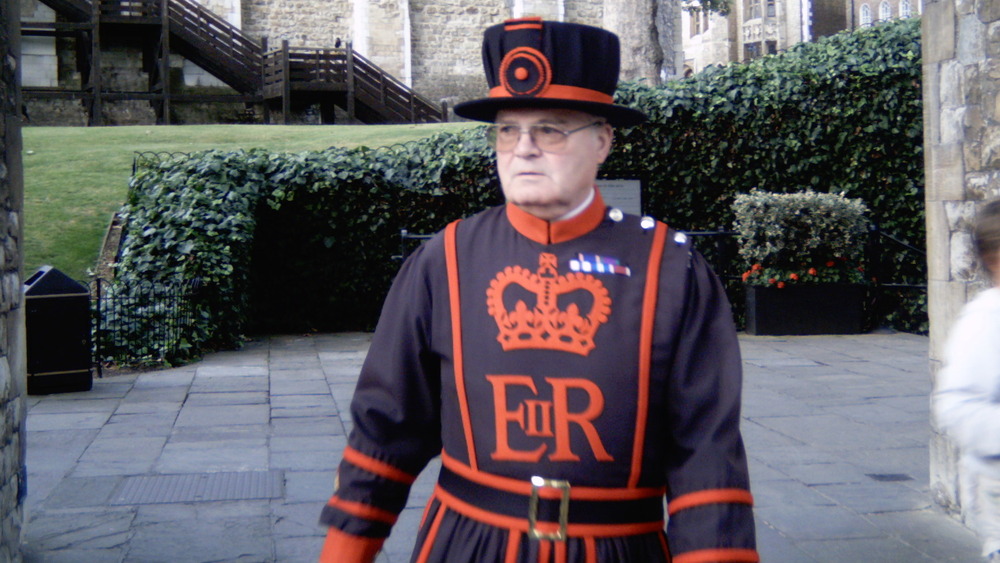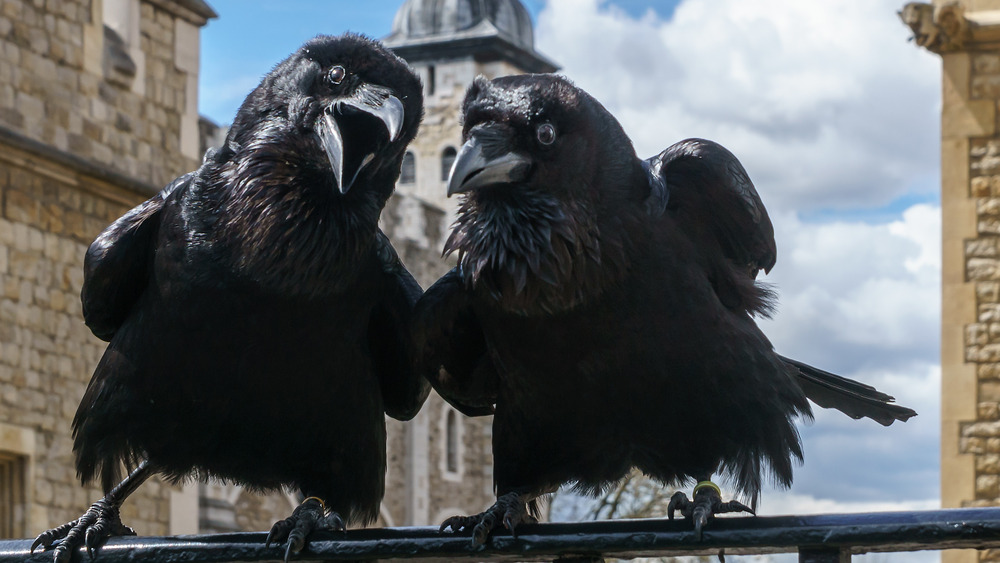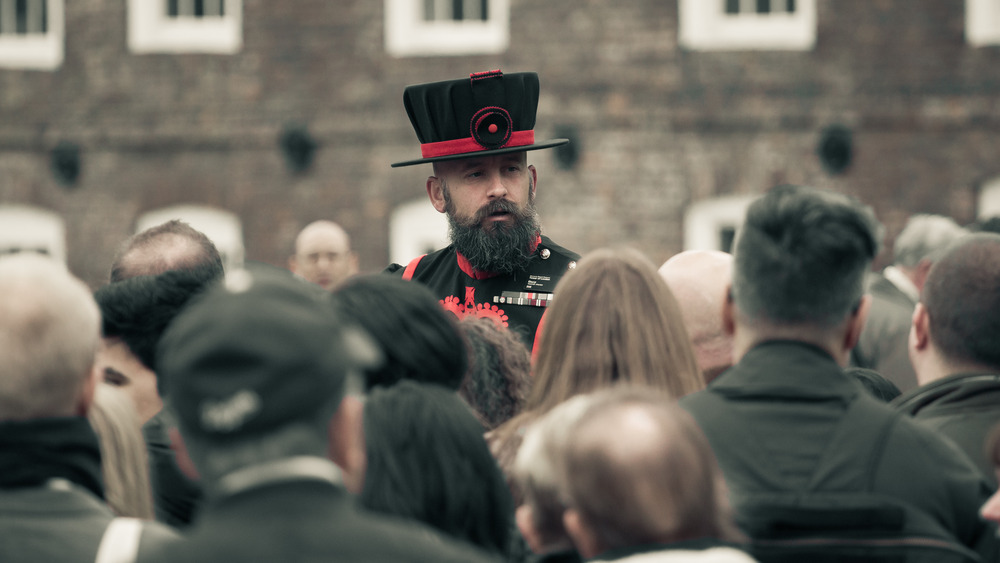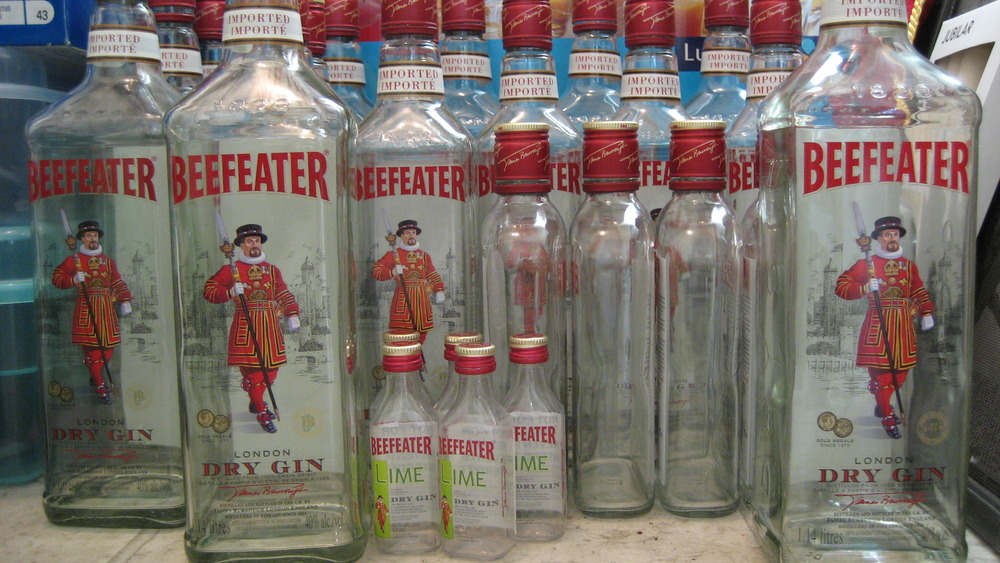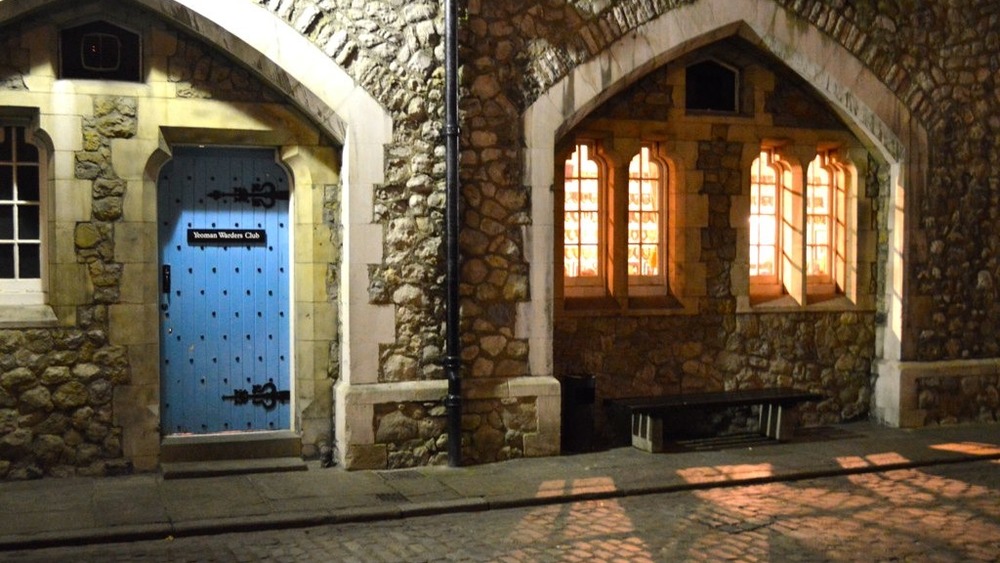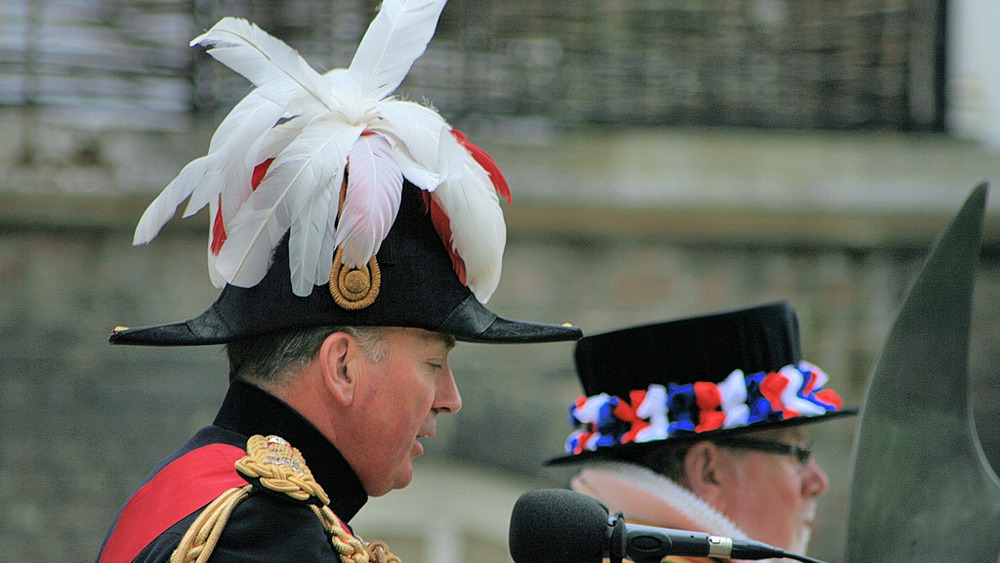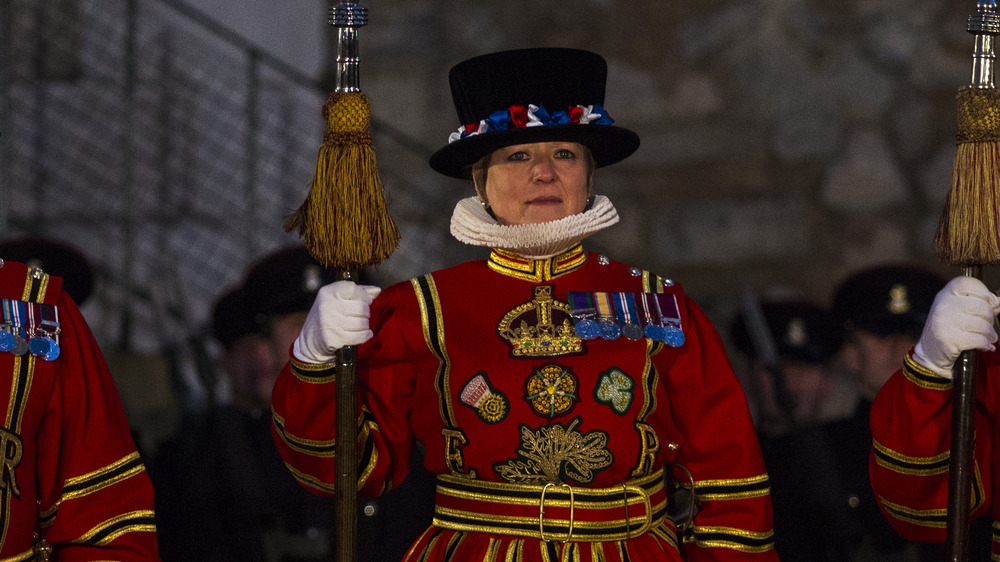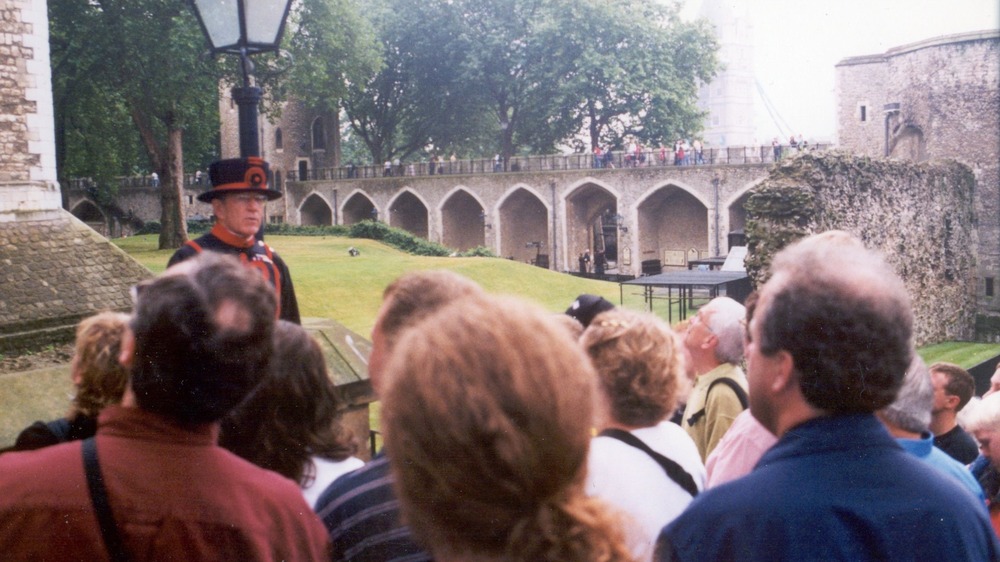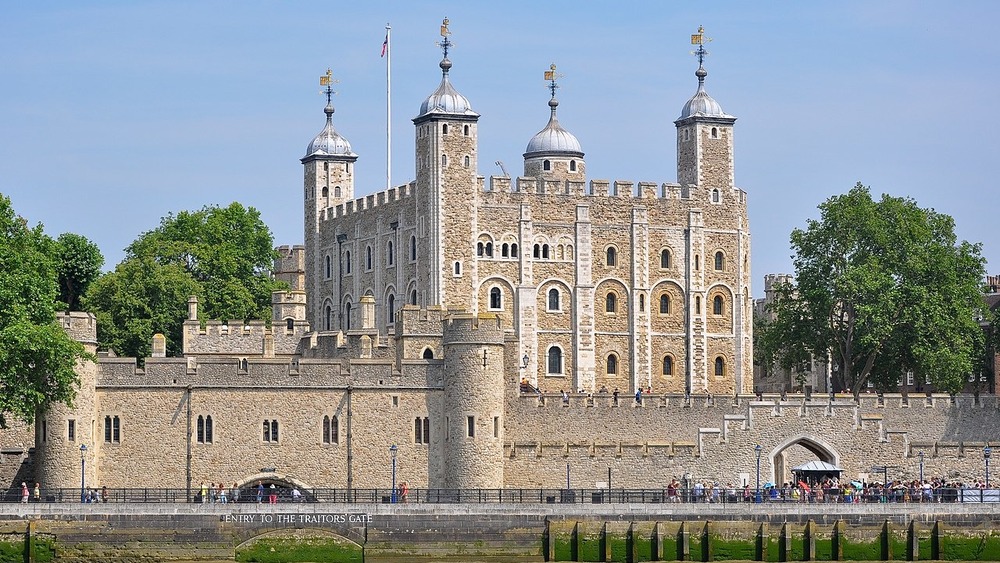What It's Really Like Being A Beefeater
Most people are introduced to Beefeaters in two distinct ways. The first is by a certain highly popular gin label that features a British soldier dressed in deliciously outlandish garb wielding a pike. Second, for those of a much younger generation who in no way, shape, or form should be familiar with the hard liquor, may have watched the computer-animated film, Minions, which features the eponymous characters first hypnotizing three Beefeater guards and then dealing with a final blind Beefeater "Boss," who is immune to their brainwashing ray gun.
These adult and comical tropes have shaped the public imagination of what being a Beefeater is like. Of course it is 99% false — with the exception of the uniforms and weapons. The Beefeaters, who are properly called Yeoman Warders, have a long history that is completely distinct from other ceremonial soldiers in the United Kingdom, such as the bearskin hatted Palace Guards. They also serve a function today that is completely different from their original intent. Let's take a look at what it's really like being a Beefeater, and then maybe you can decide if it is a good occupation for you.
The Beefeaters were royal torturers in Tudor England
The Beefeaters have a venerable tradition dating back to 1485. In that year, according to HistoryExtra, Henry Tudor defeated Richard III at the Battle of Bosworth, which was the last significant fight of the Wars of the Roses. Henry took on the regnal name of Henry VII and founded the famous Tudor dynasty. According to a 19th century history by Thomas Preston, the new king, coming off of the hangover of two decades of violent power struggles, sensibly feared for his own safety. So even before he was crowned, he formed a special soldiery called the Yeoman Guard. Of these, the contingent that guarded the Tower of London became known as the Yeoman Warders, later nicknamed Beefeaters.
Originally, the Beefeaters were essentially prison guards since the Tower locked up high-profile dissenters of Tudor England. According to Historic UK, the Beefeaters carried out torture during the time of upheaval in the 16th and 17th centuries. Their main torture tools were the rack, which stretched people out and tore limbs from sockets, and the Scavenger's Daughter, which compressed its victims (the opposite of the Rack). They also hung prisoners by the wrists on manacles.
Fortunately, if you want to be a Beefeater today, you do not need to learn torture techniques, since after the time of the Tudors, the Yeoman Warders as a position evolved to become ceremonial. Just to clarify, not ceremonial torturers but rather ceremonial guards.
Where does the name Beefeater come from?
There are several theories as to the origin of the nickname "Beefeater." Thomas Preston offers in his history that the term may have come from the French. He cites that the term "beefeater" may have come from buffetier, who were French royal guards who protected and taste-tested the king's food.
Preston also cites a story that he believes is the most likely origin of the term. Henry VIII on a hunting expedition decided to dress up as a Yeoman Guard and went to visit an abbey. The abbot, seeing what was apparently a royal guard, invited him to dinner where the king devoured a large portion of beef. The abbot had a squeamish constitution and said to the disguised king before he left that he would pay £100 if he could eat beef like him. Shortly after the abbot was arrested and imprisoned in the Tower of London with a diet of bread and water. Finally, one day the abbot was given a large portion of beef, which he consumed voraciously. While eating, Henry VIII entered and demanded £100 for restoring the abbot's appetite. Afterward the abbot thought of all the king's warders as "beef eaters."
Other theories are numerous as reported by the The Guardian, such as a popular theory that the Yeoman Warders were paid in beef or they tasted the royal food to prevent poison. The true origin to their obscure sobriquet will likely never be corroborated.
The Beefeaters are guardians of the crown jewels
Aside from being fancily dressed prison guards and torturers, the Beefeaters were to traditionally guard the crown jewels, according to Great British Magazine. The Royal Collection Trust relates that this collection, contained in the Tower of London's Jewel House, contains regalia dating back to the 17th century. In fact, a ceremony emphasizes the security function of the Beefeaters. Atlas Obscura details how at 9:53 p.m. every evening, a ceremony of the guard occurs where the keys are inspected and "the Tower is secured for the evening."
This is all purely ceremonial of course, since prisoners are not held at the Tower of London anymore, and modern technology calls on more sophisticated means to protect the crown jewels. MyLondonNews points out that the security protecting the crown jewels is state-of-the-art. Digital closed caption cameras coupled by a special detachment of 22 active duty military personnel keeps a close watch on the treasure. In addition, any thief would have to get through a bomb-proof case. However, the Beefeaters these days act as a supplementary guard in case anyone capered to filch the jewels.
Beefeaters get to wield obsolete weapons and dress in quaint uniforms
The eternal image of a Beefeater is that of the resplendent scarlet and gold uniforms wielding a pike. According to the BBC, this is the formal "Tudor State Dress," which is worn during occasions of state or when the monarch is visiting the Tower. This uniform dates back to 1549. They are also expensive to purchase. A new uniform was valued at £3,500 in 2007 by the BBC. On other days, Beefeaters wear the blue and red "undress uniform." This particular outfit was only introduced in 1858 with the approval of Queen Victoria.
If you do become a Beefeater, you have the opportunity to wield a halberd (sometimes called a pike or partisan). According to Warfare History Network, halberds evolved from earlier battle axes. The long pole weapon was very effective at unseating mounted cavalry. The type that the Beefeaters are equipped with are more decorative in nature, possessing more elaborate patterns than real fighting pikes, which became obsolete by the 16th century. However, if the Tower of London is attacked by a contingent of fierce knights on war steeds, the Beefeaters are duly armed and ready.
Beefeaters also take care of ravens on a diet of blood-soaked biscuits
The coolest sounding title in any military service in the world is the Beefeater's "Ravenmaster." According to Historic UK, the Tower of London has had resident ravens since at least the 17th century when an astronomer complained to King Charles II that the birds were meddling with his work. Before the king could finalize killing the ravens, he learned of a legend that said that if the ravens left the Tower evil would befall the kingdom. The king, therefore, decreed that there must always be six ravens kept at the Tower of London. Thus, the Ravenmaster was born.
The current Ravenmaster tends seven ravens, not six just in case one has an untimely demise. The birds, kept in cages with clipped wings, are fed a diet of blood-soaked biscuits, raw meat, and an occasional rabbit with the fur still intact. Mental Floss reports that according to the Ravenmaster, Christopher Skaife, the birds will eat berries, nuts, "and what they nick off the tourists."
The ravens at the Tower have in fact fallen lower than six, declining just to one during the time of the London Blitz, when the birds departed from the noise. However, in recent years the Ravenmaster has been involved with a breeding program to ensure that there is an ample stock of ravens to fend off disaster.
Beefeaters are great tour guides
So if Beefeaters aren't torturing prisoners or seriously defending the Tower of London, what do they do? Their main duty, according to Historical Royal Palaces, the non-profit that administers the Tower, is providing tours of the Tower. The route, which is a one-way circuit through the site, features the White Tower built by the Normans and the Traitors' Gate, which Atlas Obscura details was a gate built over a waterway in which high profile prisoners were ferried into the Tower of London for imprisonment and potential execution such as Sir Thomas More. These tours even include, according to the Londonist, a severed hand embedded in the masonry — this is apparently an "unofficial" attraction.
As frequent videos around the web show, these tours are a mixture of humor and history that do much to educate the almost 3 million visitors to the site in 2019, according to VisitBritain. The coronavirus pandemic of 2020 resulted in a shut down of these tours.
The Beefeaters invaded America
Few people may know, but the Beefeaters invaded the United States in the mid-20th century — in the form of hard liquor. As detailed by the Spirits Business, Beefeater gin was established by James Burrough in 1876. The bottles, sporting an image of a Beefeater in Tudor State Dress, became and still is a dominant gin brand. As the Beefeater gin history proudly proclaims, it was the only gin selected to be stocked aboard the Queen Elizabeth II for its maiden voyage in 1963. In fact, by that time, which coincides with rock 'n' roll's British invasion, 75% of all bottles of gin imported into the United States were the Beefeater brand. The brand seemingly has not lost its popularity. Statista reports ever increasing sales of Beefeater gin with 3.4 million 9-liter cases sold in 2019.
The connection between the real Yeoman Warders and Beefeater gin is purely marketing in nature. However, while the Beefeaters may have increased the recognition of the brand, in many ways the reverse is true. The well-known gin label has undoubtedly raised the public's awareness of the real Beefeaters and has probably driven (hopefully sober) tourists to the Tower of London.
Beefeaters have their own secret pub
Speaking of drinking, one perk of being a Beefeater is that they have their own semi-secret club at the Tower of London. As the BBC reports, the Yeoman Warders Club is the last of many such pubs that existed on the grounds of the Tower. These served the resident or semi-resident population that no longer exists. The club itself is private to just the 37 Beefeaters and their invited guests, which in the past have included Bruce Willis and Tom Clancy. Atlas Obscura notes that the club is also called the "Keys" after the evening lock up ceremony, and sports unique decor featuring red leather benches, jailor axes, and even an autograph by the Nazi officer Rudolf Hess who was imprisoned at the Tower for four days in 1941. Aside from being stocked with copious amounts of Beefeater gin, the club also offers a locally brewed "Yeoman 1485" and "Beefeater Bitter."
It is at the club that Beefeaters induct new members into their very exclusive order. Using silver tankards that line the bar, the Beefeaters have new members swear an oath of allegiance. When done, the old guard replies, "May you never die a Yeoman Warder."
The constable of the Tower of London is the Beefeaters' boss
The Beefeaters have a boss, and that is the constable of the Tower of London. This position actually predates the Beefeaters themselves. According to Historic Royal Palaces, the position was established by William the Conqueror around the year 1078 as keeper of the Tower. It was changed to constable the next century.
The constable was in charge of the Tower's security, maintenance, and those who lived in it. As part of his compensation, the constable by rights could seize any swan that found its way under London Bridge, livestock that fell off the bridge into the Thames, and any wagon that fell off the bridge. Much more lucrative was that the constable was also entitled to a portion of every cargo that came by ship and docked at the Tower Wharf. This tradition is somewhat carried on today when ships from the Royal Navy present the constable with a barrel of wine as part of his "dues."
Much like the Beefeaters, the role of the constable is now entirely ceremonial, and there does not seem to be any instances of him arresting swans swimming under London Bridge.
The first woman Beefeater was appointed in 2007
The Beefeaters were an entirely male occupation from the time of Henry VII. However, this changed in 2007 when Moira Cameron was inducted. According to the BBC, Cameron was a 22-year army veteran. At the time, Cameron said, "It's just a wonderful job and I'm very, very lucky to have it. You wake up in the morning and you know you're going to have a good day." To become a Beefeater, Cameron trained for two months on the various ceremonies and tour duties she would be giving on a daily basis.
However, Cameron did not always have good days. Early on, one of the employees of the Tower said he was against her being a Beefeater. According to The Guardian, she replied, "I would like to thank you for dismissing my 22 years' service in Her Majesty's armed forces." Then in multiple reports, including one by the BBC, Cameron was subjected to bullying by her male colleagues and superiors. This resulted with the firing of two Beefeaters, as reported by The Guardian in 2009.
Perhaps to emphasize the fact that Cameron was not to be a solitary phenomena, in 2017 Amanda Clark became the Tower of London's second woman Beefeater. When interviewed by the BBC, Clark said, "It didn't really hit me until the first time I wore the uniform and realized I am now part of the Tower's history."
I want to be a Beefeater! How do I sign up?
You should know up front that the qualifications needed for being a Beefeater are stiff. The BBC notes that all Yeoman Warders need to have at least 22 years of service in the British armed forces and have reached the rank of warrant officer. In addition, you need to have stayed out of trouble. All Beefeaters need to hold the Long Service and Good Conduct medal.
And job duties? Forces.net quoted one Beefeater hiring advertisement as stating, "As part of the Yeoman Body, your main responsibilities will include ensuring that all our visitors receive a Royal Welcome when visiting HM Tower of London, conducting large parties of visitors around the Tower, relating its history and stories, contributing to the safety and security of the Tower and taking part in ceremonial duties and parades."
At the time of their appointment, Beefeaters have to be between the ages of 40 and 55. The Londonist notes that applicants for the position should also show an interest in royal history. It also would be probably helpful if a potential Beefeater is photogenic, since the likelihood is that he or she would be featured in countless tourist photos and videos. The pay doesn't seem to be bad either — in 2017 The Telegraph reported that Beefeaters got paid about £30,000.
Even Beefeaters can't escape COVID-19
While normally the Tower of London is one of Britain's premier tourist attractions, it, like everywhere in the world, has been impacted by the coronavirus pandemic. The Tower of London was forced to close in the spring of 2020. By July, multiple news sites, including CNN, reported that the 37 Beefeaters were being eyed for layoffs as a part of measures to reduce costs due to the economic fallout of the pandemic.
The problem is that tourist money drives in 80% of Historic Royal Palaces revenue. While the organization offered a voluntary way to sever service in June 2020, the pressure was such that mandatory cuts loomed. While this has not occurred yet, if it did it would be unprecedented in the 500 year history of the Yeoman Warders. In what may be a bad omen, in January 2021, The New York Times reported that one of the Tower's ravens, a female named Merlina, had gone missing. Even though the Ravenmaster had a spare raven, it was a hard blow in a crushing year.
It is easy to imagine in the idle hours caused by the pandemic, the Beefeaters gathered at their private club, kicking their heels, and making the solemn toast, "May you never die a Yeoman Warder."
